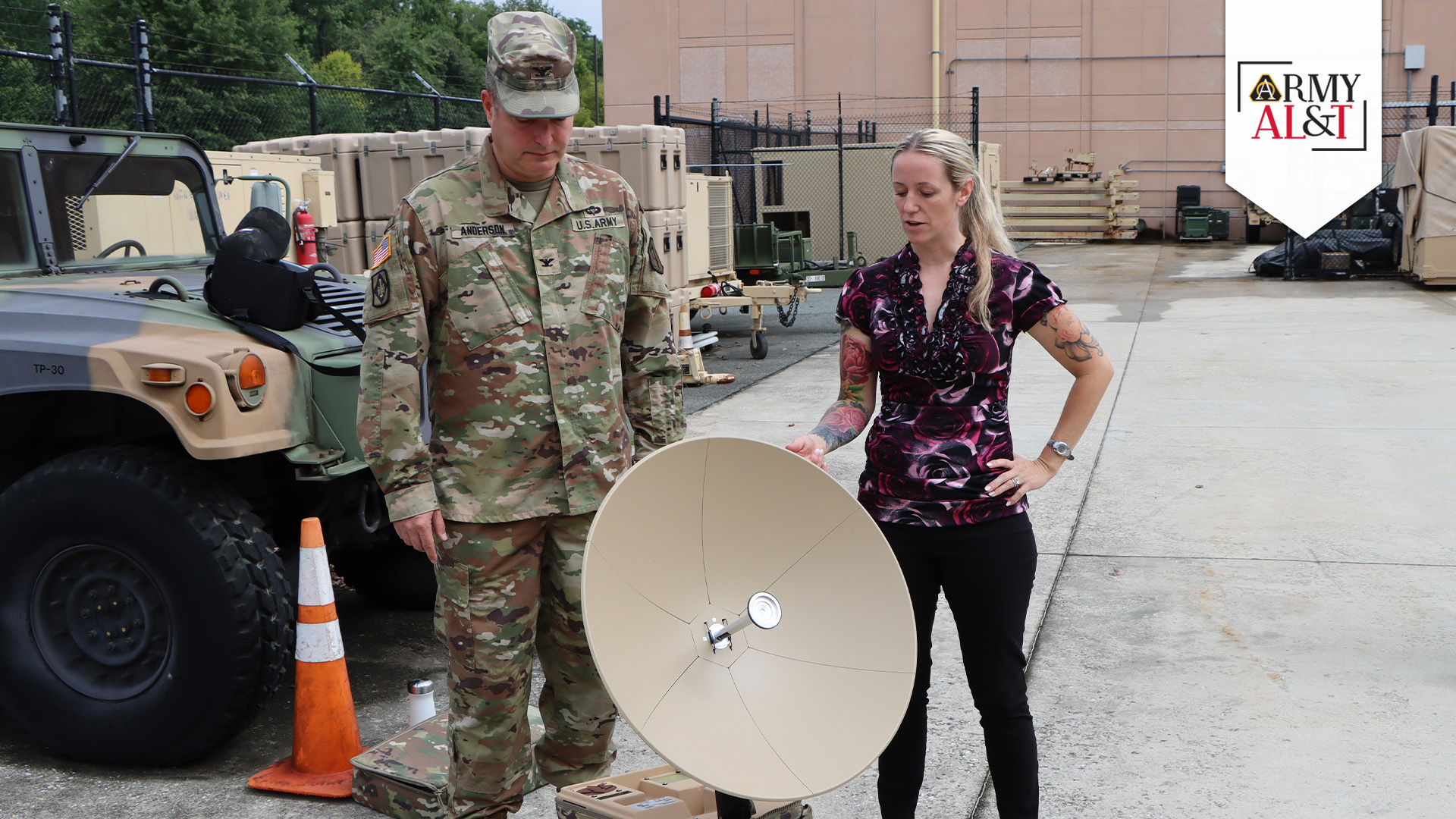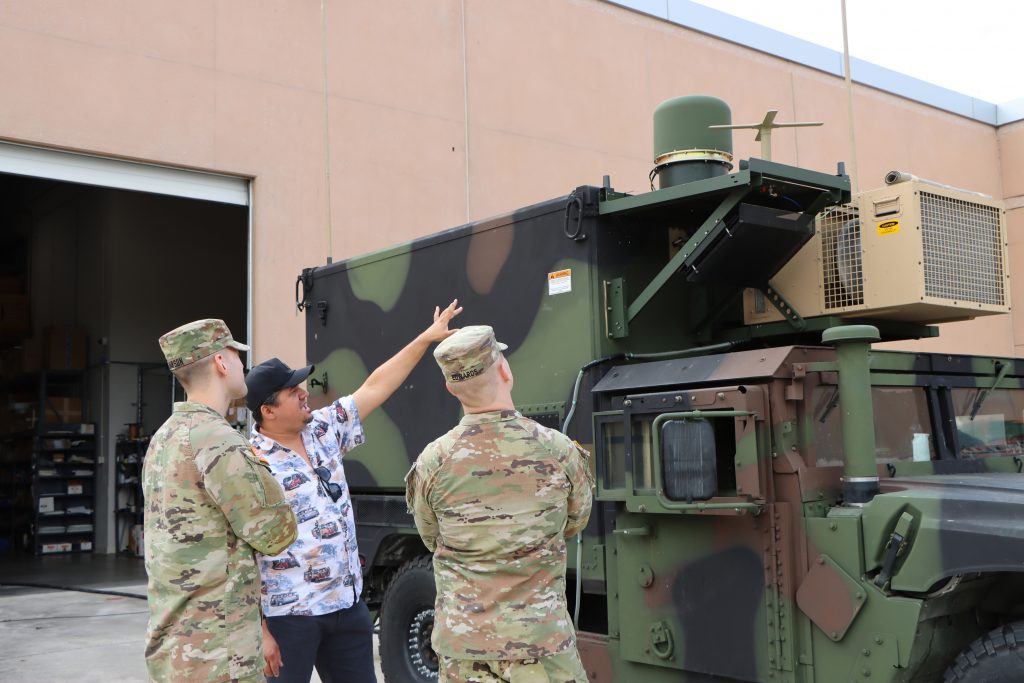
COMMUNICATIONS CAPABILITIES: Col. Chris Anderson and TGS Product Lead, Kathleen Wilt, PM IS&A, stand next to a PRS 11, while discussing TGS Lot G capabilities at Aberdeen Proving Ground, Aug. 7, 2024. (Photos by Dean Hunter, PM IS&A)
Soldier involvement during testing brings value to Army modernization efforts.
by Courtney Savage
Intelligence is critical to any mission. If Soldiers do not know what they’re up against, they may be unable to reach their objectives or could suffer physical injury. Getting the most accurate and timely intelligence to units on the ground is paramount—and so is developing an intelligence system that is tailor-made for the Soldiers it will serve.
Involving end-users in an iterative development process helps ensure a system is aligned with their needs and provides valuable insights to validate and inform design decisions and tradeoff analysis. The Army accomplishes this by conducting Soldier touch points (STPs). STPs are conducted early to identify user requirements that need to be met and pain points with currently fielded equipment that need to be redesigned as they are modernized. They are also conducted throughout various stages of development to iteratively refine system design. Post-fielding their conduct identifies system enhancements, new requirements and any missed usability issues. STPs are documented in a program’s Human Systems Integration (HSI) Plan in accordance with Army Regulation 602-2, Human Systems Integration in the Systems Acquisition Process.
STP PARTNERSHIP
In selecting participants for STPs, it is critical to have representative end-users to conduct testing. Nearly every state’s Army National Guard has a military intelligence unit. Ideally, STPs would be a mixture of Army and Army National Guard members to investigate issues unique to each. To support this methodology, Program Executive Office Intelligence, Electronic and Warfare Sensors’ Project Manager Intelligence Systems and Analytics (PM IS&A) is partnering with the 629th Intelligence Electronic Warfare Battalion (IEW BN) from the Maryland National Guard to ensure that Soldiers will be able to effectively use their intelligence ground stations by incorporating Soldier feedback into the development of the Tactical Ground Intelligence Station (TGS) Lot G—a vehicle-mounted system that is part of the Distributed Common Ground System-Army (DCGS-A). It is used for posting, processing and distributing real-time intelligence, surveillance and reconnaissance information to intelligence analysts and commanders.
The TGS Lot G is a modernization effort of the currently fielded TGS Fleet. The TGS Lot G is leveraging a prototype testbed to test and demonstrate the operational utility of theater command and control with tactical low-Earth orbit and high-altitude long endurance assets with sensor data downlink and dissemination to the warfighter. Additionally, this effort promises to provide enduring capabilities and bridge the modernization gap by addressing sustainability of aging hardware, security, accreditation, maintenance and enhancement of current and future TGS mission requirements; focusing on the system’s key infrastructure for data processing, storage and networking hardware; and reshaping the limits of current technology by replacing legacy sensor and communication components with innovative solutions.
These updates are intended to enhance hardware, software applications, tools and communications to address obsolescence within legacy systems and bridge the gap to the Tactical Intelligence Targeting Access Node (TITAN), which is planned to subsume the TGS fleet. In particular, the TGS Lot G will serve as a risk reduction effort for the TITAN Basic variant that will be fielded at the brigade combat team and division echelons. Partnering with industry, PM IS&A has integrated cutting-edge radios, antennas, computers and satellite downlinks in an efficient Humvee-based platform.
There are currently 101 TGS systems fielded across the Army, with 39 of those systems maintained and operated by Army National Guard.
A number of usability issues with the TGS have been captured during STPs. Notable to Army National Guard units is the inclusion of controlled cryptographic items (CCI) and communications security keys. Most National Guard unit home stations have little to no standoff distance, requiring the removal of all CCI between system usage for storage. This makes it logistically difficult for units to properly use and train on their systems.

FULLY CAPABLE: Second Lt. Nicholas Dawson and Spc. James Edwards listen to the Fort Cavazos TGS Operator New Equipment Training Geospatial Intelligence Trainer, Giovanni Nieves, discuss the Lot G’s quad band on the move capabilities and the satellite communications Ultra High Frequency antenna at Aberdeen Proving Ground, on Aug. 7, 2024.
OVERCOMING OBSTACLES
CW2 Ryan Kriesch, a military intelligence systems technician with the Minnesota Army National Guard, participated in a recent TITAN STP. Much of the qualitative feedback shaping TITAN is directly related to lessons learned from the TGS fleet. Kriesch shared his insights into the unique challenges impacting mission readiness that all National Guard units face with their legacy TGS systems. “Training is a tremendous obstacle in being able to effectively use complex military intelligence systems as most [National Guard] Soldiers will only be afforded 20 days or less of true training hours per year,” he explained. “These time constraints are often exacerbated by not having a functioning system for Soldiers to employ their tradecraft.”
For units that can get their TGS operationally functional, there are still obstacles to overcome to ensure Soldiers can achieve proficiency on their fielded systems. “With training hours dedicated to set up, emplacing antennas, and tear down, it leaves little if any time to connect into the wider division or brigade architecture,” Kriesch said.
Although the current TGS documentation covers internal server and architecture configuration, there are documentation gaps when integrating the DCGS-A software baseline with other programs of record within the TGS, including the Global Broadcasting System, One System Remote Video Terminal and Embedded National Technical Receiver.
Col. Chris Anderson, PM IS&A, understands the importance of fielding usable systems to all Army components. He challenged his team to design the ultimate Humvee-based intelligence ground station that leverages the latest in antenna, data link, radio and compute technology in driving the TGS Lot G design. Not only did his team design it, but they also built a prototype that the 629th Expeditionary Military Intelligence Battalion (E-MIBn) debuted at the request of Col. Michael A. Bryant, 58th Expeditionary Military Intelligence Brigade commander for the Maryland Army National Guard, and successfully showcased to Army senior leaders during the Fulcrum Strike 24 exercise distinguished visitor day. Anderson noted that, “TGS Lot G is a prime example of passionate and dedicated acquisition professionals and our military intelligence Soldiers pushing the art of the possible.”
Lt. Col. Joseph Pieper, commander of the 629th E-MIBn, emphasized the importance of adaptability and technical proficiency within the Military Intelligence Branch. “The battalion’s collaboration with PM IS&A reflects this vision, as they work together to develop systems that provide revolutionary solutions for commanders’ situational understanding in complex environments,” Pieper said.
The battalion’s involvement in the TGS Lot G development has not only contributed to the system’s technical advancement, but has also fostered a culture of continuous learning and growth among its personnel. According to Pieper, Soldiers are the experts on the dynamics of military intelligence units, further enhancing the battalion’s operational effectiveness.
The next major event for the TGS Lot G is a risk reduction event (RRE) and assessment of its capabilities. The assessment will take place with a variety of system configurations which will include using the Mission Command Domain Warfighter Integrated Network-Tactical network infrastructure as a reach-back network and in a stand-alone off network configuration. Army Capability Manager – Foundation or ACM-F and U.S. Army Forces Command, a TGS stakeholder, will support the RRE and assessment. PM IS&A’s HSI team is integral to the design of the assessment and for the collection and analysis of Soldier feedback.
During the TGS Lot G RRE and assessment, Soldiers will set up, tear down and operate the system. The HSI team will collect qualitative and quantitative Soldier feedback. Mixed and multiple data collection methods with rigorous human performance metrics will be used during STPs to increase confidence in the reliability of results. For example, during hands-on usability testing, Soldiers perform typical tasks as described above with minimal or no training to increase a system design’s intuitiveness and effectiveness. Soldiers rate the ease of use and the cognitive workload experienced when performing the tasks. Test facilitators capture performance bottlenecks, those points where Soldiers “get stuck” and need assistance to continue a workflow for both hardware and software tasks. Tasks and workflows that do not meet a pre-established threshold for human performance metrics will undergo a tradeoff analysis where qualitative feedback tied to those tasks, including Soldier-suggested mitigations, help inform any HSI recommendations made to the TGS team.
CONCLUSION
Human Systems Integration tradeoff analysis covers seven domains: human factors engineering; manpower; personnel; training; habitability; occupational and health safety; and force protection and survivability. The PM IS&A’s HSI and training development experts ultimately inform the human factors engineering, manpower, personnel, training and habitability domains. PM IS&A obtains matrix support from the Defense Health Agency to conduct the Health Hazard Assessment (HHA) to inform the occupational and health safety domain. (For organizations seeking similar support, requests for HHAs can be made at https://phpubapps.health.mil/HHAR.) After the RRE and assessment is completed and HSI recommendations are made, the 629th IEW BN will continue to conduct STPs with the TGS Lot G over the next 18 months and the feedback from those events will refine future requirements. PM IS&A’s partnership with the 629th IEW BN supporting the development of the TGS Lot G will ensure that Soldiers, especially Army National Guard units, will be able to effectively use their intelligence ground station. This partnership ensures that the U.S. Army and National Guard remains equipped with the tools necessary to maintain a strategic advantage in intelligence operations, now and in the future.
For more information about TGS Lot G assessment, contact Nate Jones at nathaniel.jones267.civ@army.mil.
COURTNEY SAVAGE is the HSI lead at PM IS&A and has practiced user-centered design for over five years since beginning her practitioner career there. Previously, she supported the Army’s HSI Directorate in the development of policy and regulation. She has a B.S. in kinesiology and dietetics from Rutgers University.







